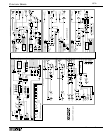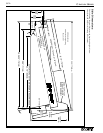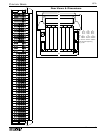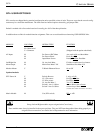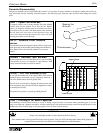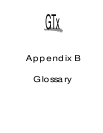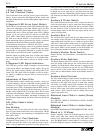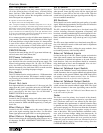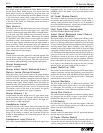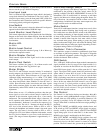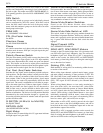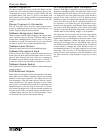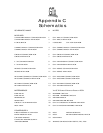
APPENDIX B
GTX
CENTURY SERIES
assign level, providing maximum level when in the center
position and continuously decreasing in level when turned to
the left or right. This makes true LEFT-CENTER-RIGHT (L-
C-R) panning possible. (See also BUS ASSIGNMENT, PAN
Switch)
PAN Switch
With the PAN switch up, groups can be individually selected
and are unaffected by the PAN control. With PAN switch
down, the PAN control varies the level of the group assign-
ments with odd numbered groups on the left and even num-
bered groups on the right.
PEAK LED
See 5-SEGMENT LED ARRAY
PFL (Pre-Fader Listen)
See SOLO
Phantom Power
See 48V PHANTOM POWER
Phase
All console connections are in phase with each other, including
insertion sends & returns. XLR pin 2 and jack tip are the posi-
tive (+) phase connectors.
Polarity Reverse Switch
This post insert return, pre-EQ switch reverses the phase of the
line and microphone input signals in the GTx input modules
(on the stereo input module, this switch acts upon one channel
only). This feature can be used to adjust phase cancellation
between microphones when more than one microphone is pick-
ing up the same acoustical signal. See also User Options.
Pre/Post (Aux) Fader Switches
Switches the Aux signal sources between pre-fader and post-
fader positions. The pre-fader position is usually used for mon-
itor sends, so that any movement of fader level does not affect
these outputs. When in the post-fader position, signal output
level from the Aux sends will proportionally follow the main
signal level. The result is maintenance of an effect in propor-
tion to the main signal level. When an input signal is faded to
0dB, the post-fader Aux Send signals are also decreased to
0dB. In some cases, it may be desirable to derive effect sends
pre-fader for special effects, such as those generated by a vocal
doubler or harmonizer. The choice of switch position should be
determined by the actual situation; though as a general rule,
choose the pre-fader position for monitor sends and post-fader
position for effect sends.
Q SWITCH (Hi Mid & Lo Mid EQ)
See EQ SECTIONS
RETURN JACK
(See INSERT/RETURN JACKS)
Right Meter
Located on the GTx meter bridge, this VU-type meter indicates
the Right output level, post fader.
Scene Mute Assignment Switches
On input modules, the scene mute switches assign the input to
one or more of the master scene mutes. On the group modules,
the scene mute switches assign the Effects Return to one or
more of the master scene mutes. These mutes are activated via
the scene mute master switches found on the master section.
Any combination of mutes is allowed.
Scene Mute Master Switches
Found on the GTx Master Section, these switches
activate/deactivate the four scene mutes. Associated red LED's
indicate status.
Scene Mute Safe Switch w/LED
This switch, found on input and group modules beneath the
Scene Mute Assignment Switches, disables any selected scene
mutes, and is generally used to prevent accidental channel mut-
ing. A green LED indicates that the Safe switch has been
engaged.
Signal Present LED’s
See 5-SEGMENT LED ARRAY
SOLO LEFT/SOLO RIGHT Meters
Located on the GTx meter bridge, these VU-type meters indi-
cate PFL/AFL signal level. Inherently, they also reflect the
headphone signal level. When PFL or AFL is engaged any-
where on the console, the SOLO LEFT and SOLO RIGHT
level meters go from being dimly lit to being the same bright-
ness as the other level meters.
Soloing (PFL/AFL)
Both methods of soloing allow for monitoring within the mas-
ter section of the console
When soloing input channels, optional matrix inputs, groups
and main outputs, monitoring is done pre-fader, or PFL. The
PFL (Pre Fader Listen) switch enables the operator to listen to
channel signals before the fader or main channel level control
(PFL). This signal IS NOT affected by the Channel Mute
Switch.
When soloing Matrix Masters or Aux sends, monitoring is
done after-fader (AFL); the associated AFL (After Fader
Listen) switches enable the operator to listen to Matrix Master
and AUX signals after the rotary Matrix Master /Aux level
controls. When soloing a single Matrix Master or Aux signal
individually, monitoring is done in ‘mono’; when soloing more
than one Matrix Master or Aux signal, solo monitoring will be
heard as a stereo ‘split’, odd on left, even on right.
When either an AFL or PFL switch is pressed, the solo signal
level can be seen on the Solo Left/Right meters, and can be
heard both in the mixer’s headphone output and on the rear
panel monitor output of the console.
When PFL or AFL is engaged anywhere on the console, the
SOLO LEFT and SOLO RIGHT level meters go from being
dimly lit to being the same brightness as the other level meters,
and two red LED's on the console panel illuminate.



